Google's Pixel 7a Is Just as Good as the Regular Pixel 7
The Google Pixel 7a is the new go-to mid-range Android device. It’s so good that it’s making me question why anyone should buy a regular Pixel 7. I chose the Pixel 7 because I wanted a smaller, cheaper device with similar camera capabilities to the Pixel 7 Pro. But now that the Pixel 7a is out for just $500 and is so good, Google is clearly going to have difficulty justifying why anyone should spend the extra $200 for the base Pixel 7's extra goodies.
Fortunately, I saved money on my Pixel 7 because I traded in a Pixel 3. But for other folks in a similar predicament, consider the Pixel 7a to save money on an Android smartphone that can still take excellent photos. Google is leaning hard into its Pixel camera algorithms, as it’s proven they can take a pretty picture, all aided by the Google-made Tensor G2 processor. This machine learning-focused chip is in both the base Pixel 7 and the 7a, again allowing the cheaper sibling to keep up with its older brother.
The 7a offers some other high-end smartphone goodies, like wireless charging, a screen with a 90Hz refresh rate, and face unlocking. The Pixel 7a is the best deal for anyone who hasn’t already bought a Pixel 7.
Read more
These Winning Close-Up Photos Show Life That's Often Overlooked
Remembering Enterprise: The Test Shuttle That Never Flew to Space
The Pixel 7a packs some pretty colors
The Pixel 7 and Pixel 7a are hardly discernable from the back, save for their specific colorways. Both have dual rear camera systems embedded into what is now the signature Pixel camera bar, with matching aluminum trimming around the chassis. You can see the width disparity in the camera bar between the Pixel 7 and 7a, but they look like the same device from afar. The Pixel 7 is only larger than the 7a by about three millimeters. They even carry the same heft, with the Pixel 7a lighter by about four measly grams.
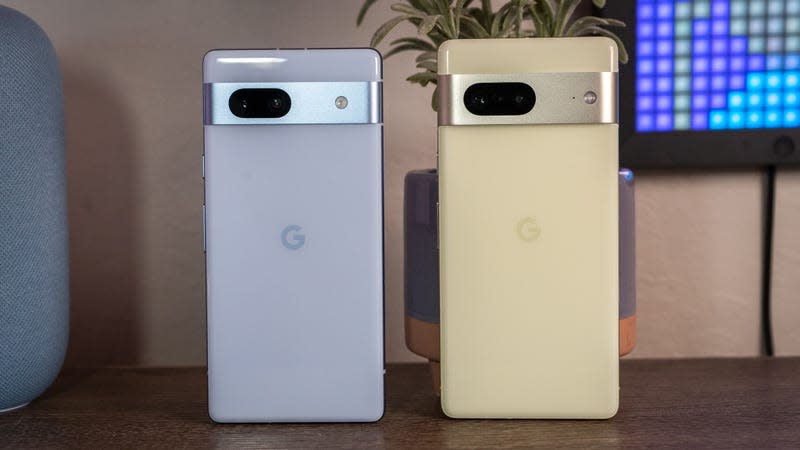
The Pixel 7a (left) compared to the Pixel 7 (right).
The Pixel 7a comes in four colors. In addition to the standard black and white offerings, there is a sky blue variant of the Pixel 7a, featured here, and a red-orange version available exclusively through the Google Store. The colors are gorgeous in person, matching the soft palettes of the Pixel hardware lineup. The Pixel 7a is also IP67 dust and water-resistant, so an accidental drop in the pool won’t kill the smartphone if you take it out quickly.
The display on the Pixel 7a is a 6.1-inch OLED. It can be bumped up to a 90Hz refresh rate, but by default, the phone is set to 60Hz. There is a difference in smoothness scrolling through screens between the 7's constant 90Hz and the 7a’s default of 60Hz. I tested the phone with its default because I wanted to get the best battery life, and I’ll share the test results in a bit. The phone has a high brightness mode in direct sunlight and an FHD+ display resolution like the Pixel 7.
Google’s Tensor G2 Chip: Round two
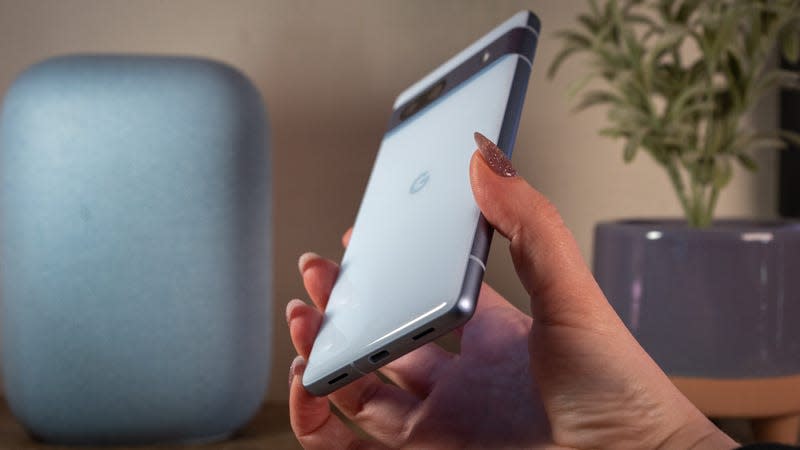
A good, solid blue phone.
Inside, the Pixel 7a runs on nearly the same innards as the Pixel 7. There’s a Google Tensor G2 processor coupled with 8GB of RAM, two more gigabytes than Google offered last year in the Pixel 6a. I live with that amount of RAM daily with the regular Pixel 7 and can confirm that this is enough for constant use, including Pokémon Go, TikTok, switching between Gmail and Slack, and every other fast-moving thing that I do on a smartphone to get my work done. It’s even quick at fingerprint and face unlock. It’s nice to see this kind of hardware coupling in mid-range devices because it promotes longevity. Google can quickly push software updates to the device for as long as it supports the chip. This move also mirrors Apple’s plan with its smartphones, including the iPhone SE, which all utilize a variant of its homemade Bionic processor.
Like the Pixel 7, the Pixel 7a feels snappy and fast. Typically, mid-range devices at this price point, like the Samsung Galaxy A54 and last year’s Pixel 6a, max out at 6GB. But I will say, as a current Pixel 7 user, that I would prefer Google add more RAM to its smaller flagship lineup if it’s setting the A-series standard at 8GB.
The Tensor processors aren’t mega performers like Qualcomm’s Snapdragon variants, as Google’s tuned them for machine learning. Unfortunately, Geekbench 6 was not available for the 7a at the time of writing. But I did run WebXPRT 2015 benchmarks, which we use to measure features like browser-based face detection and photo editing. The Pixel 7a performed only 50 points better than its predecessor, the Pixel 6a.
The Pixel 7a is limited to 128GB of storage space, which isn’t much. I like to buy at least 256GB because I take many photos, download attachments for work, and scrape Instagram for memes. Those files add up fast. Many Android manufacturers have done away with the expansion slot in favor of other features, including Google with the Pixel smartphone.
Pixel 7a has a good battery, but not the best
According to its internal testing numbers, Google says the 4385 mAh battery in the Pixel 7a can last up to 24 hours. In our battery benchmark, where we run down the device with a 24-hour YouTube video displayed at 200 nits, the Pixel 7a lasted about 16 hours and 11 minutes. That’s an hour less than last year’s Pixel 6a and about half an hour less than Samsung’s pocket-sized Galaxy S23. It’s possible you could get that whole 24-hour battery life if the screen stays off most of the time. But according to our tests, you’ll still want a battery pack handy if you’re heading out for a long day.
The Pixel 7a does boast some flagship-level features with the battery, including fast charging and Qi-compatible wireless charging. I do appreciate that this is part of the 7a’s mid-range story, as I have many wireless charging pads around my home, and I prefer to use them instead of plugging in devices. It’s good to know that the 7a can make use of those.
Pixel 7a’s flagship-level camera
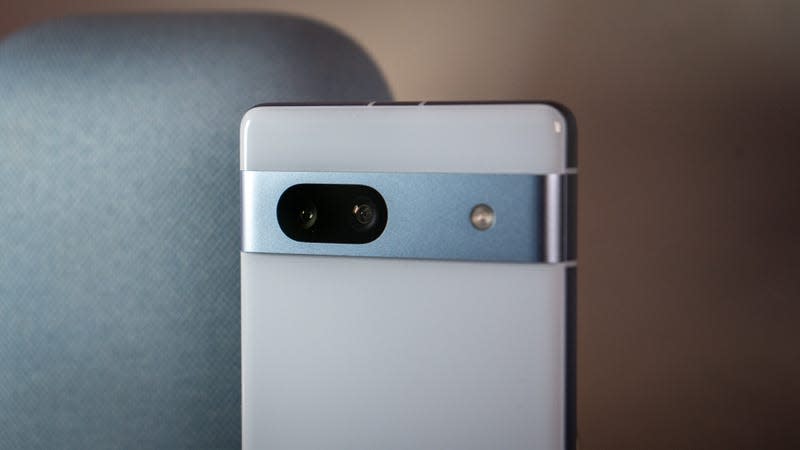
The Pixel 7a includes two cameras but no telephoto lens.
The real upside of the Google Tensor G2 CPU is that it’s the key to why the 7a takes photos like the Pixel 7. I was impressed—I could barely tell the difference in my photos across the two devices despite the difference in camera glass, whether I was shooting at night or casually while on my daily walks.
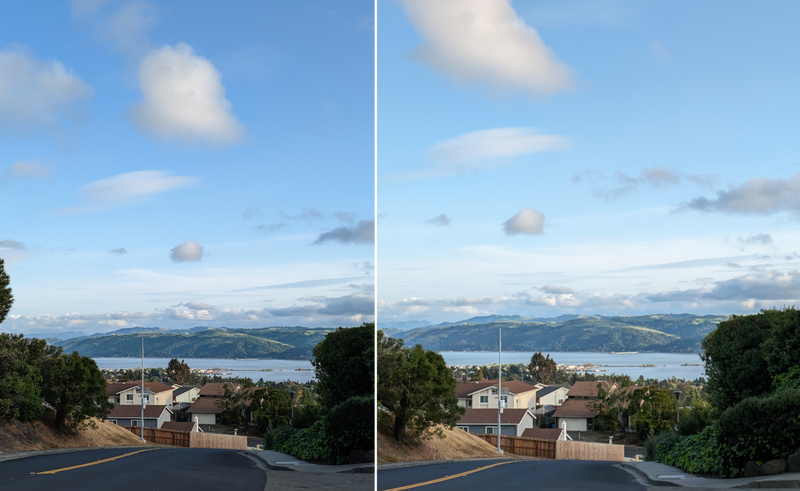
From left to right: the Pixel 7 compared to the Pixel 7a.
The Pixel 7a has a 64-MP primary camera with OIS, a f/1.89 aperture, and an 80-degree field of view. It can perform AI-enhanced digital Super Res Zoom up to 8x. The second camera is a 13-MP ultrawide camera with a 12-degree FoV. The front-facing camera is a 13-MP fixed focus lens, better than the 10.8-MP sensor currently in the Pixel 7. My biggest complaint with the Pixel 7 is that the front-facing camera is muddy in low-light situations, but I didn’t feel that with the Pixel 7a. The Pixel 7a can shoot up to 4K video at 60fps.
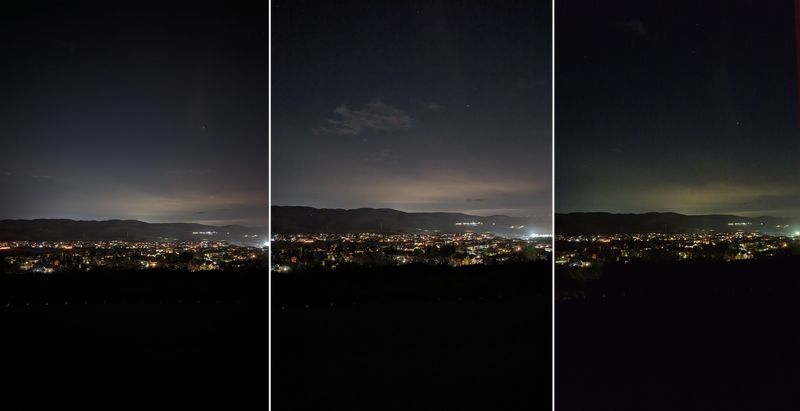
From left to right: Pixel 7, Pixel 7a, Galaxy A54.
The Pixel 7a took some stellar photos. I had to categorize them as I took them to tell the difference between snapshots taken with the Pixel 7. I also tested the Pixel 6a and Galaxy A54 alongside the Pixel 7a, and while the 6a kept up, the Galaxy A54 struggled to sharpen detail in low-light settings. But not the 7a, which managed to light up subjects and far away sky in a level on par with its flagship brethren. I did notice some differences in clarity and coloring between the Pixel 7's lenses and those of the Pixel 7a. In that first photo sample I pasted above, for instance, you can see more detail on the hills in the distance in the Pixel 7 sample compared to the Pixel 7a.
Don’t forget the Pixel feature drops
The Pixel 7a runs Android 13 right out of the box and comes with the promise of five years of consistent software updates. But Google’s way of enticing you to use its hardware is with a constant barrage of Pixel feature drops. They’ve previously included improvements to older devices like the Pixel 6 and exclusive features only for Pixel devices. The Pixel 7a will be added to the lineup so that you can take advantage of AI-infused capabilities like Call Assist and Magic Eraser.
Save on a flagship, buy the Pixel 7a
If you are looking for an Android smartphone to carry you through your days, the Pixel 7a is a complete package, even at its $500 price point (it’s $550 for the mmWave model, by the way). Currently, it does cost a little more than the Galaxy A54, which is Samsung’s version of the same device. The trade-off is that you get a screen with a higher refresh rate and a slightly bigger battery—Samsung packed in a 5,000 mAh pack. But what you won’t get with Samsung’s $450 device is a camera system on par with its flagships. That’s where the Pixel 7a still reigns supreme.
What will happen to the base Pixel 7? Google will have to make that particular release more punchy, because it currently exists to serve the same niche of users as the A-series. At the very least, if you want to take astrophotography or a photo of a person’s face in a poorly lit bar, you can do so with the $500 Pixel 7a without springing the total price for one of Google’s flagships.
More from Gizmodo
Sign up for Gizmodo's Newsletter. For the latest news, Facebook, Twitter and Instagram.

